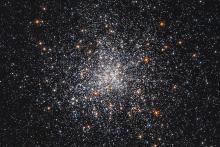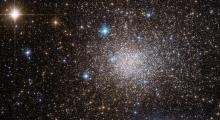Listen to today's episode of StarDate on the web the same day it airs in high-quality streaming audio without any extra ads or announcements. Choose a $8 one-month pass, or listen every day for a year for just $30.
You are here
New Cluster
The brightest planet and star in all the night sky are in good view at dawn right now. The planet Venus is low in the east. It’s the “morning star,” so it’s a brilliant target. And the star Sirius twinkles far to the upper right of Venus. No other star in the night sky outshines it.
Astronomers have long viewed the splendor of Sirius — first with the unaided eye, then with telescopes large and small. But through all these years of looking, they’ve missed something: a cluster of stars that lies in nearly the same direction as Sirius but far beyond it, in the outer part of the Milky Way galaxy.
The cluster was discovered in data from the Gaia space telescope, which is measuring the distances and velocities of a billion stars. Astronomers spotted a collection of stars just a sixth of a degree east of Sirius — about the width of a toothpick held at arm’s length. The stars were all the same distance from Earth: about 15,000 light-years, indicating they belong to a cluster, now named Gaia 1.
The cluster is 38,000 light-years from the Milky Way’s center. That’s 11,000 light-years farther out than the Sun and Earth are. The cluster is about 60 light-years across, and it emits 10,000 times more light than the Sun.
Such a bright cluster should have been seen long ago. It eluded detection by hiding behind the glare of Sirius. As a result, it took a sensitive new spacecraft to unveil this star-filled denizen of the Milky Way’s outer reaches.
Script by Ken Croswell, Copyright 2017





